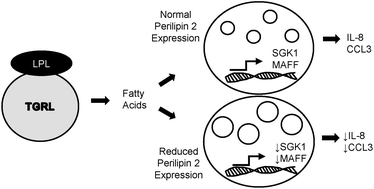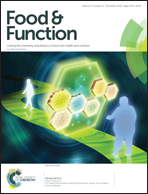Inhibition of perilipin 2 expression reduces pro-inflammatory gene expression and increases lipid droplet size†
Abstract
Our lab previously demonstrated that triglyceride-rich lipoprotein (TGRL) lipolysis products induce lipid droplet formation and pro-inflammatory gene expression in monocytes. We hypothesized that the inhibition of perilipin 2 expression in THP-1 monocytes would reduce lipid droplet formation and suppress pro-inflammatory gene expression induced by TGRL lipolysis products. In the current study, we use microarray analysis to identify gene expression altered by TGRL lipolysis products in THP-1 monocytes. We confirmed the expression of selected genes by quantitative reverse transcription PCR and characterized lipid droplet formation in these cells after exposure to TGRL lipolysis products. Using siRNA inhibition of perilipin 2 expression, we examined the role of perilipin 2 in the response of THP-1 monocytes to TGRL lipolysis products. We found that perilipin 2 siRNA increased the intracellular triglyceride content, increased the size of lipid droplets, and reduced pro-atherogenic and pro-inflammatory gene expression. We saw a reduction of serum/glucocorticoid kinase 1, v-maf musculoaponeurotic fibrosarcoma oncogene homolog F (avian), chemokine (C–C motif) ligand 3, and interleukin 8 gene expression induced by TGRL lipolysis products. This study supports previous findings that reduction of perilipin 2 expression is protective against atherogenesis, while finding an unexpected increase in lipid droplet size with reduced perilipin 2 expression.



 Please wait while we load your content...
Please wait while we load your content...